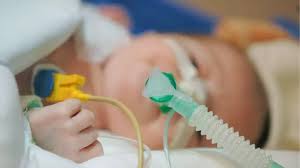Researchers have made a significant breakthrough in predicting the health outcomes of infants with hypoxic-ischemic encephalopathy (HIE) using EEG and MRI data. A recent study, published in JAMA Network Open by Hannah C. and colleagues, shows that combining clinical data with electroencephalography (EEG) and magnetic resonance imaging (MRI) can help accurately predict death or severe neurodevelopmental impairment (NDI) in newborns treated with therapeutic hypothermia for moderate to severe HIE.
This finding provides hope for improving early prognostication and clinical decision-making in the care of these vulnerable infants.
Study Details
The study followed 424 neonates born at or beyond 36 weeks of gestation between January 2017 and October 2019 as part of a large US clinical trial. All infants had moderate or severe HIE and were treated with therapeutic hypothermia, a cooling therapy known to improve outcomes in HIE cases.
Key Data Collected:
- Clinical information (e.g., Apgar scores and blood pH levels).
- EEG readings at 24 hours.
- MRI results after therapeutic cooling.
The infants were monitored for two years to assess outcomes, focusing on death or severe NDI, including developmental and motor impairments.
Findings and Models
The study developed two predictive models based on clinical data, EEG, and MRI findings:
1. 24-Hour Model
- Combined data from severely abnormal EEG, pH levels ≤ 7.11, and a 5-minute Apgar score of 0.
- Results:
- Specificity: 99.6% (extremely high accuracy in ruling out unaffected cases).
- Positive Predictive Value (PPV): 95.2% (confidence in predicting death or severe NDI).
This model showed consistent accuracy during internal and external validations, though the PPV was slightly lower in the external cohort.
2. Postcooling Model
- Combined MRI findings of abnormalities in two or more deep gray matter regions (e.g., thalamus, caudate, putamen) with severely abnormal EEG at 24 hours.
- Results:
- Specificity: 99.1%.
- PPV: 91.7%.
This model performed reliably in both internal and external validations, maintaining high accuracy in predicting severe outcomes.
What the Data Shows
- Of the 424 newborns in the study:
- 13.9% (59 infants) died by age two.
- 10.8% (46 infants) developed severe neurodevelopmental impairments.
- These predictive models provided clinicians with a practical way to identify high-risk infants early and tailor interventions accordingly.
Why This Study Matters
For infants with moderate or severe HIE, time is critical. Predictive models using EEG and MRI data provide doctors with:
- Accurate Early Prognostication: Helping parents and healthcare providers make informed care decisions.
- Improved Resource Allocation: Allowing hospitals to focus specialized care on infants most at risk.
- Better Outcomes: Supporting timely interventions that could improve survival and developmental prospects.
Practical Applications
This study confirms that simple clinical models combining EEG and MRI can accurately predict outcomes like death or severe NDI in newborns with HIE. These models can:
- Enhance clinical decision-making.
- Guide early parent counseling.
- Streamline NICU interventions for high-risk infants.
Conclusion
This groundbreaking research highlights the potential of EEG and MRI in neonatal care. For infants with hypoxic-ischemic encephalopathy, these tools, combined with clinical data, provide a reliable way to predict long-term outcomes. Such advancements not only improve the quality of neonatal care but also bring hope to families navigating these challenging situations.
To register for our next masterclass please click here https://linktr.ee/docpreneur




